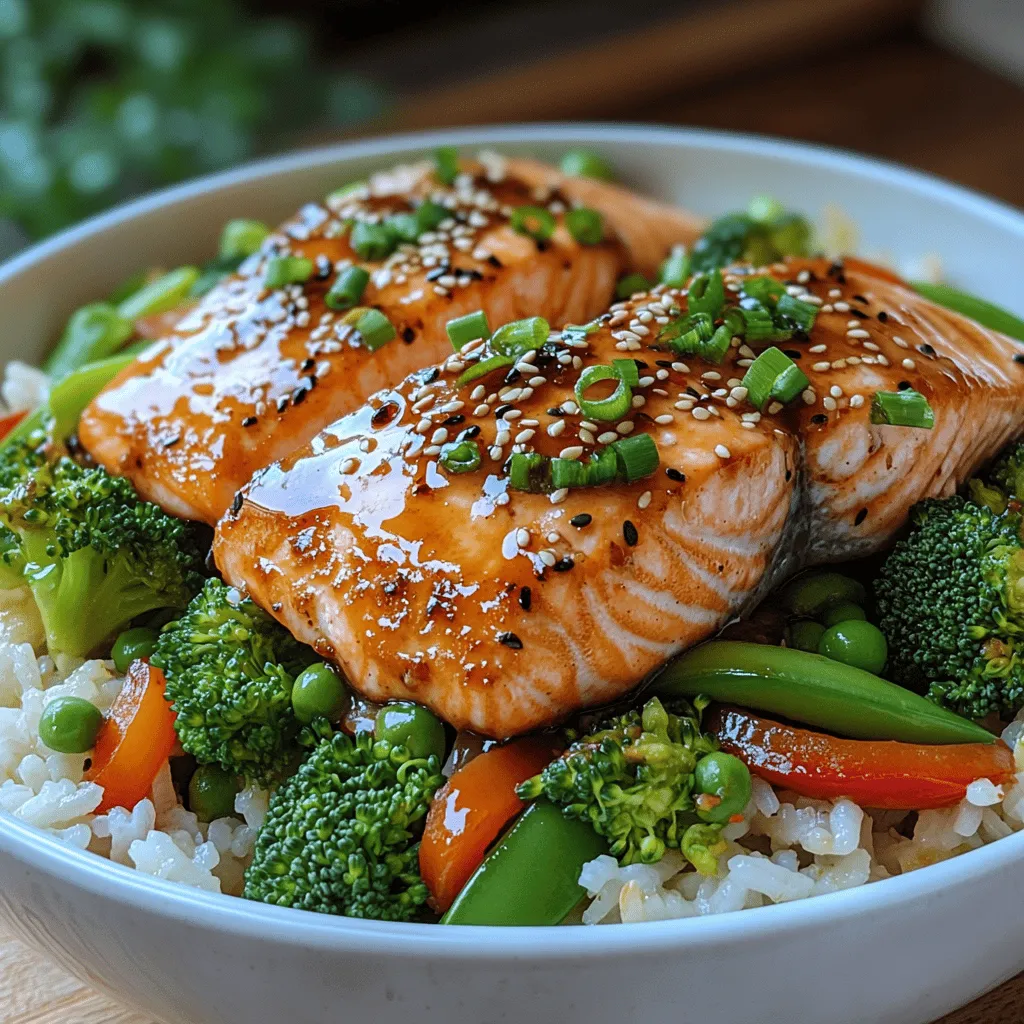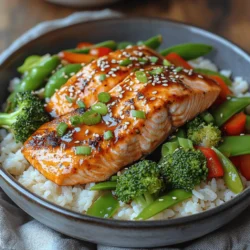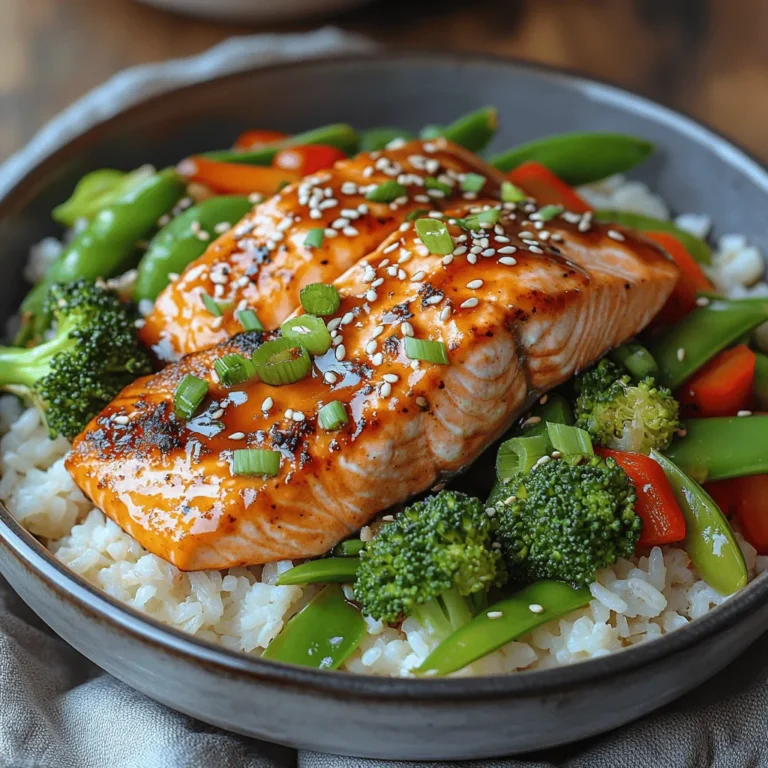Introduction
The One-Pan Teriyaki Salmon & Veggie Rice Bowl is a delightful dish that marries the rich flavors of teriyaki sauce with the freshness of vegetables and the heartiness of salmon. This recipe not only tantalizes the taste buds but also offers a well-rounded meal that is perfect for busy individuals and families. One-pan recipes like this one are ideal for those with limited time, as they require minimal preparation and cleanup while still delivering a nutritious and satisfying meal.
The balance of flavors and nutrition in the Teriyaki Salmon & Veggie Rice Bowl makes it a favorite among health-conscious eaters. The combination of succulent salmon, crisp vegetables, and fragrant jasmine rice creates a colorful and appetizing dish that is sure to please anyone at the dinner table.
Ingredients
– 2 salmon fillets
– 1 cup jasmine rice
– 2 cups water
– 1 cup broccoli florets
– 1 red bell pepper, sliced
– 1 cup snap peas
– 1/4 cup teriyaki sauce
– 2 tablespoons olive oil
– 1 teaspoon garlic, minced
– 1 teaspoon ginger, minced
– Salt and pepper to taste
– Optional: sesame seeds and green onions for garnish
Instructions
1. Prepare the Marinade: In a small bowl, mix together teriyaki sauce, minced garlic, and minced ginger. Place salmon fillets in a shallow dish and pour the marinade over them. Allow them to marinate for at least 15 minutes.
2. Cook the Rice: Rinse jasmine rice under cold water until the water runs clear. In a medium saucepan, combine rinsed rice and 2 cups of water. Bring to a boil, then reduce heat to low, cover, and simmer for 15 minutes or until the rice is tender and water is absorbed. Remove from heat and let it sit covered for another 5 minutes.
3. Sauté the Vegetables: In a large skillet or pan, heat olive oil over medium heat. Add broccoli, red bell pepper, and snap peas. Season with salt and pepper, and sauté for about 5-7 minutes until the vegetables are tender yet crisp.
4. Cook the Salmon: Push the sautéed vegetables to one side of the skillet. Add the marinated salmon fillets to the other side of the pan, cooking for about 4-5 minutes on each side or until the salmon is cooked through and flakes easily with a fork.
5. Combine and Serve: Fluff the cooked jasmine rice with a fork and divide it among serving bowls. Top with the sautéed vegetables and the cooked salmon. Drizzle any remaining teriyaki sauce over the top, and garnish with sesame seeds and green onions if desired.
The Benefits of One-Pan Meals
One-pan meals offer significant time-saving advantages for meal preparation, making them an excellent choice for those with busy lifestyles. With everything cooked in a single pan, you can efficiently prepare dinner without spending too much time in the kitchen, allowing for more quality moments with family or friends.
Minimal cleanup is another key benefit of one-pan meals. After enjoying your delicious Teriyaki Salmon & Veggie Rice Bowl, you can simply wash one pan instead of multiple pots and dishes, making post-meal cleanup quick and easy.
Additionally, these meals provide versatility in ingredients, meaning you can customize the dish to suit your dietary preferences. Whether you prefer different vegetables, alternative proteins, or even a vegetarian version, the one-pan concept allows for creative freedom in the kitchen.
Understanding the Key Ingredients
The primary components of the One-Pan Teriyaki Salmon & Veggie Rice Bowl are salmon, teriyaki sauce, and fresh vegetables, each bringing unique flavors and nutritional benefits to the dish. Salmon is rich in omega-3 fatty acids, which are essential for heart health, and it’s an excellent source of high-quality protein.
The teriyaki sauce plays a crucial role in flavor enhancement, adding a sweet and savory element that complements the richness of the salmon. It is typically made from soy sauce, mirin, and sugar, creating a balanced taste that elevates the entire dish.
Fresh vegetables are vital in this recipe, contributing not only to the meal’s vibrant color appeal but also to its health benefits. Broccoli, bell peppers, and snap peas are packed with vitamins, minerals, and fiber, making the One-Pan Teriyaki Salmon & Veggie Rice Bowl a nutritious choice for any meal.
Marinating the Salmon: Techniques and Tips
To create the perfect marinade for the salmon, combine teriyaki sauce, minced garlic, and ginger in a bowl. This mixture not only infuses the fish with flavor but also helps to tenderize it, enhancing the overall texture of the dish.
Marinating salmon is a simple yet effective technique that allows flavors to penetrate the fish deeply. For optimal flavor infusion, let the salmon marinate for at least 15 minutes, or up to an hour for a more intense taste. Just be cautious not to marinate for too long, as the acidity in the sauce can break down the fish’s texture.
Cooking the Rice: Achieving Perfect Jasmine Rice
Cooking jasmine rice involves a few simple steps to achieve that fluffy texture. Start by rinsing the rice under cold water to remove excess starch, which can cause the rice to become gummy during cooking. This step is essential for achieving the perfect grain consistency.
In a medium saucepan, combine the rinsed rice with water, bringing it to a boil before reducing the heat and letting it simmer. Cover the pot to trap steam, which helps cook the rice evenly. After 15 minutes, remove the rice from heat and allow it to rest covered for an additional 5 minutes, which allows the grains to firm up and separate beautifully.

Alternatives to Jasmine Rice
If you’re looking to switch up the base of your One-Pan Teriyaki Salmon & Veggie Rice Bowl, there are several alternatives to jasmine rice that cater to different diets and preferences:
Quinoa
Quinoa is a protein-packed grain that is gluten-free and rich in essential amino acids. Its nutty flavor and fluffy texture make it a great substitute, and it can add a nutritional boost to your dish.
Brown Rice
For a heartier option, brown rice offers more fiber and nutrients compared to white rice. It has a chewier texture and a mild flavor that complements the teriyaki salmon beautifully.
Cauliflower Rice
If you’re following a low-carb or ketogenic diet, cauliflower rice is an excellent alternative. It’s made by grating cauliflower into rice-sized pieces and lightly sautéing it, providing a vegetable-packed base that absorbs flavors well.
Barley
For a unique twist, consider using barley. It has a chewy texture and a slightly nutty taste, contributing to a satisfying bowl. Barley is also a good source of fiber and various vitamins.
Sautéing the Vegetables: Ensuring Vibrant Flavor and Color
Techniques for Sautéing Vegetables
To maintain the crunch and vibrant colors of your vegetables, use high heat and a quick cooking method. Start with a hot pan and a small amount of oil to ensure the vegetables sear rather than steam. Stir frequently and avoid overcrowding the pan, which can lead to sogginess.
Ideal Vegetable Combinations
For the best flavor and texture, consider using a mix of bell peppers, broccoli, snap peas, and carrots. These vegetables not only add color but also provide a variety of nutrients and crunch that pairs well with the salmon and rice.
Seasoning Tips
Enhance the natural flavors of the vegetables by adding a pinch of salt, a splash of soy sauce, or a sprinkle of garlic powder during cooking. A touch of sesame oil added at the end can also elevate the flavor profile.
Cooking the Salmon: Achieving the Perfect Texture
Best Practices for Cooking Salmon
When cooking salmon, the choice between skin-on and skinless can influence the texture of your dish. Skin-on salmon tends to retain moisture better and can be crisped up beautifully in the pan. If you prefer skinless, just ensure that you monitor cooking time closely to avoid dryness.
Timing and Temperature
To achieve perfectly cooked salmon, aim for an internal temperature of 145°F (63°C). Depending on thickness, salmon fillets typically require about 4-6 minutes per side over medium-high heat. Use a meat thermometer to check doneness without cutting into the fish.
Using Leftover Marinade
Don’t waste the leftover marinade! Brush it onto the salmon during cooking to enhance the flavor and create a delicious glaze. Just be sure to cook it thoroughly, as it has been in contact with raw fish.
Assembling the Bowl: Presentation and Serving Suggestions
Steps for Assembling the Rice Bowl
Start by placing a generous serving of your chosen rice in a bowl. Layer the sautéed vegetables on one side and the cooked salmon on the other. This not only helps with visual appeal but also allows diners to mix flavors according to their preference.
Garnishing
To finish off the bowl, sprinkle sesame seeds and chopped green onions on top. This adds a fresh crunch and a pop of color, making your dish visually appealing and inviting.
Optional Toppings and Variations
Consider adding avocado slices, pickled ginger, or even a soft-boiled egg for extra richness. Feel free to customize the bowl with your favorite toppings to make it your own.
Nutritional Information
A typical serving of the One-Pan Teriyaki Salmon & Veggie Rice Bowl contains approximately 500 calories, with a balance of protein, healthy fats, and carbohydrates. Salmon is an excellent source of omega-3 fatty acids, while the vegetables provide essential vitamins and minerals. The meal can fit well into a balanced diet, offering a nutritious option for lunch or dinner.
For those with dietary restrictions, substitutions can be made easily. Gluten-free soy sauce can replace regular soy sauce, and plant-based proteins can be used in place of salmon for a vegetarian option.
Conclusion
The One-Pan Teriyaki Salmon & Veggie Rice Bowl stands out for its simplicity, robust flavor, and nutritional benefits. It’s an ideal meal for busy weeknights, combining ease of preparation with delicious results. By incorporating more one-pan meals into your cooking routine, you can streamline meal prep while enjoying a variety of flavors. This versatile dish has the potential to become a family favorite, adaptable to suit everyone’s tastes and dietary needs. Enjoy the process, and savor every bite!

